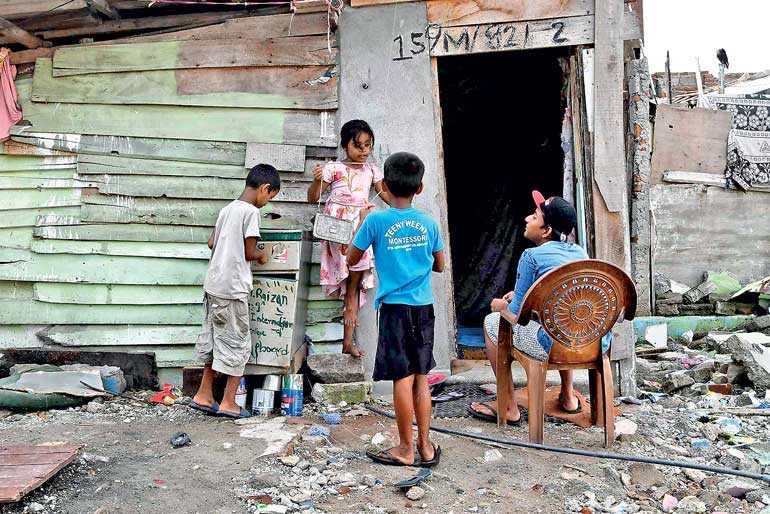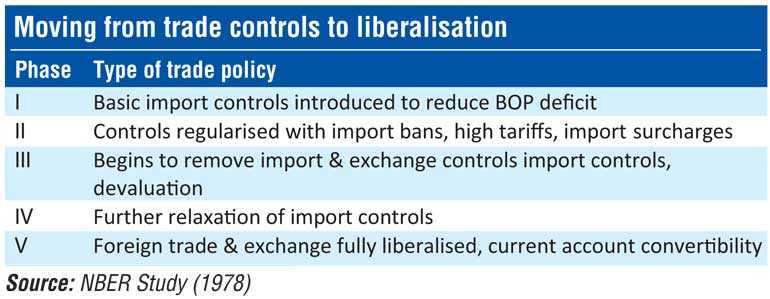Tuesday Dec 02, 2025
Tuesday Dec 02, 2025
Tuesday, 16 March 2021 00:00 - - {{hitsCtrl.values.hits}}

The actual number of people living below the poverty line in Sri Lanka is about 10 times bigger than the mere 4.1% of population, as reflected in official statistics – Pic by Shehan Gunasekara
 In Sri Lanka, around 40% of the population lives below the poverty line, according to expert opinion based on the survey data for 2016, in contrast to the official poverty ratio of only 4%. In the backdrop of the COVID-19 pandemic, the poverty ratio is likely to have reached nearly 50% of the population by now.
In Sri Lanka, around 40% of the population lives below the poverty line, according to expert opinion based on the survey data for 2016, in contrast to the official poverty ratio of only 4%. In the backdrop of the COVID-19 pandemic, the poverty ratio is likely to have reached nearly 50% of the population by now.
Adequate attention has not been given to poverty reduction in policy formulation agendas in recent times.
An outward-looking trade policy aiming at export-led economic growth is imperative for poverty reduction, as evident from the fast-grown East Asian countries and emerging Asian economies such as Vietnam and Bangladesh.
SL’s actual poverty 10 times bigger than official estimate
According to the Department of Census and Statistics (DCS), Sri Lanka’s headcount poverty index dramatically declined from 22.7% in 2002 to 4.1% in 2016, as per consumption approach. In computing this poverty index, DCS has used the National Poverty Line (NPL).
The limitations of using the NPL for poverty estimation have been articulated in his incisive article by Wimal Nanayakkara, Senior Visiting Fellow at the Institute of Policy Studies (IPS) and former Director General of the Department of Census and Statistics (https://www.ips.lk/talkingeconomics/2020/02/05/measuring-poverty-within-sri-lankas-new-reality-as-an-upper-middle-income-country/).
He suggests that the World Bank’s Global Poverty Line (GPL) is more appropriate for estimating the headcount index in keeping with international standards. The current NPL is based on the market values of an outdated basket of goods and services drawn from the Household Income and Expenditure Survey conducted by DCS way back in 2002.
The World Bank’s poverty thresholds vary with the member country’s per capita Gross National Income (GNI). With her per capita GNI of $ 4,060, Sri Lanka reached the Upper-Middle Income Country (UMIC) status ($ 3,996 – $ 12,375) in July 2019, and hence, people who live below $ 5.5 daily income per person are poor based on GPL relevant to UMIC, according to Nanayakkara.
Sri Lanka’s per capita GNI declined to $ 4,010 in 2019. As it was lower than the revised July 2020 UMIC classification ($ 4,046 - $ 12,535), Sri Lanka quickly slipped back to the Lower Middle-Income Country (LMIC) status ($ 1,036 - $ 4,045) along with Algeria and Sudan, as rightly predicted by Nanayakkara. The applicable GPL for LMIC is $ 3.20.
In terms of the GPL of $ 5.5, which is applicable for UMIC, Sri Lanka’s headcount poverty index for 2019 is as much as 40.4%, according to Nanayakkara. This can still be considered as the current poverty position of Sri Lanka, as her per capita GNI is still very close to the lower end of per capita GNI of UMIC, though she is now in LMIC category.
Thus, the actual number of people living below the poverty line in Sri Lanka is about 10 times bigger than the mere 4.1% of population, as reflected in official statistics.
Export-led growth for poverty reduction
It is essential to accelerate the rate of growth of Gross Domestic Product (GDP) to overcome poverty. The main ingredient for growth acceleration is foreign trade expansion which enables developing countries to gain market access, economies of scale, capital inflows, technology infusion, productivity improvements and efficiency.
Open trade has been increasingly recognised as the key driver of employment creation and poverty reduction across the world in recent decades. Exports are critically important for economic growth, particularly for developing countries where domestic markets are small. Exports allow domestic producers to access international markets, and thereby to benefit from economies of scale.
The world-wide evidence proves that those countries that achieved high export growth are the ones that enjoy high GDP growth and extensive poverty reduction.
Sri Lanka’s backward technology and innovation
The formidable challenge currently faced by Sri Lanka is to raise her export growth at a rapid pace to achieve high GDP growth so as to reduce poverty.
The country’s export sector, which is limited to a few low-tech products particularly apparels, has failed to graduate to high-tech and high value-added exports such as electronics and bio-technology products, unlike East Asian countries. This was due to the country’s backwardness in technology and innovation.
In this regard, Foreign Direct Investment (FDI) can play a major role in fostering export growth by way of facilitating foreign capital inflows, technology infusion and foreign market access.
Trade opening and FDI inflows are found to be the major driving force behind the success stories of East Asian economies. More recent examples are India, China, Vietnam and Bangladesh. Outward-oriented economic strategies adopted in these countries, much later than Sri Lanka, led to foster export-led growth enabling millions of people to come out of poverty.
Bangladesh: from a “basket case” to an economic powerhouse
Bangladesh is a good example to illustrate how prudent economic policies can turn a poor country, which was once branded as a “basket case”, into fastest growing economy in the Asian-Pacific region. It has become the new economic leader in South Asia with annual GDP growth rate over 6% in recent years, which was driven by the three star-performers – agriculture, garment exports and worker remittances.
The key factor that fosters export-led growth in Bangladesh has been the liberal foreign investment regime by means of legal protection for foreign investment, generous fiscal incentives, concessions on machinery imports, unrestricted exit policy and full repatriation of dividends.
Prudent fiscal management too was achieved in Bangladesh containing budget deficit to 3.5 - 4.0% of GDP. It helped to lessen inflationary pressures and to maintain exchange rate stability so as to facilitate the export drive.
Export-led growth has enabled Bangladesh to reduce poverty from 40% of the population to 14%. In parallel, there have been substantial improvements in social indicators – infant mortality, maternal mortality, undernourishment, school education and adult literacy
Phases of foreign trade regimes
Sri Lanka has oscillated between inward-looking and outward-looking trade policies from time to time since Independence, and therefore, failed to sustain steady export-led growth path so as to bring down poverty levels.
Perhaps, such policy changes can be conceptualised by using the theoretical framework developed by the US National Bureau of Economic Research (NBER) in its series of studies on trade liberalisation under the direction of Anne Krueger and Jagdish Bhagwati in 1978. They divided a country’s liberalisation process into five phases from trade controls to liberalisation, as shown in the Table.
The NBER studies, drawn from the experiences from different trade regimes in a number of countries including India, Ghana, the Philippines, South Korea and Chile provided ample evidence on the benefits of trade liberalisation.
Sri Lanka’s trade liberalisation under stress
In 1977, Sri Lanka moved from Phase II (NBER classification) of stringent trade and exchange control controls to Phase III marking the initial stages of trade and exchange liberalisation. The liberalisation process had been intensified since then.
In 1994, the Sri Lankan Government accepted the obligations under Article VIII of the Articles of Agreement of the International Monetary Fund (IMF). Accordingly, all restrictions on current account transactions of the balance of payments (BOP) were removed and the Sri Lankan Rupee was allowed to be freely convertible for such transactions. This shift to Phase V (NBER classification) was a major step towards trade liberalisation.
However, the momentum of liberalisation was short-lived as various types of controls had to be imposed frequently due to the ethnic conflict, balance of payments difficulties, macroeconomic instability and external trade shocks. Thus, the country reverts back to Phases I and II from time to time.
Recent import controls
The country’s BOP situation has worsened since last year due to the COVID-19 pandemic which has adversely affected the export and tourism sectors. The external payments problems have been compounded by foreign debt commitments which amount to $ 6 billion this year. The rise in global market prices of crude oil and other commodities has further pressurised the BOP situation. The likely decline in worker remittances will further enhance the BOP deficit.
In the backdrop of BOP difficulties, the Government has imposed import controls on a number of “non-essential” goods since last year. These include motor vehicles and various other consumer durables.
These import controls have adverse implications for economic activity, GDP growth and poverty reduction.
Debt sustainability risks ignored through swaps
The Government was able to secure $ 1.5 billion swap from the People’s Bank of China last week to meet immediate BOP needs. It is reported that the Government is negotiating with India to obtain another $1.1 billion under swap facility, debt freezing arrangement and development aid.
These swap facilities are temporary solutions to overcome BOP difficulties, and hence, deeper policy adjustments are essential to address the disarrays in macroeconomic fundamentals, particularly debt sustainability risks.
Keeping IMF at distance
Overwhelmed by the Chinese swap, State Minister Ajith Nivard Cabraal claims that the Government can manage without IMF assistance. In fact, the challenge is to resolve the macroeconomic imbalances, rather than stubbornly refusing to go to IMF.
Malaysia, which had strong macroeconomic fundamentals during the Asian financial crisis, could afford to refuse bailout from IMF.
Sri Lanka’s case is totally different with her high budget deficit, unsustainable debt commitments, balance of payments difficulties, slow economic growth and more than anything else, acute poverty.
It is ideal that if these deep-rooted problems can be resolved by ourselves without seeking anybody’s assistance, leaving aside the IMF.
IMF’s conditionality requires correction of macroeconomic fundamentals with stipulated deadlines. We ourselves can make these corrections without obliging to IMF. It is not happening that way, and therefore, swaps which do not impose any corrective measures, are the easy way out for the authorities to evade the much-needed policy reforms.
So, the macroeconomic disarrays will remain unresolved forever exerting disastrous effects on the country’s economic growth. As a result, the poor who represent about one half of the population will continue to suffer without having basic human needs met.
Outward-looking strategy imperative for poverty reduction
The current restrictive trade policy measures, which are based on the inward-looking approach, have been imposed to tackle the BOP difficulties. However, they are detrimental to export-led growth and poverty reduction.
Hence, a cohesive export-led growth policy framework is essential to address the socioeconomic problems faced by nearly 50% of the population living below the poverty line. Poverty reduction, which is almost ignored in the current economic policy formulation, should be an explicit target of any future growth strategy.

(Prof. Sirimevan Colombage is Emeritus Professor in Economics at the Open University of Sri Lanka and Senior Visiting Fellow of the Advocata Institute. He is a former Director of Statistics of the Central Bank of Sri Lanka, and reachable through [email protected])